VOLVO XC90 2007 Owners Manual
Manufacturer: VOLVO, Model Year: 2007, Model line: XC90, Model: VOLVO XC90 2007Pages: 268, PDF Size: 8.57 MB
Page 141 of 268
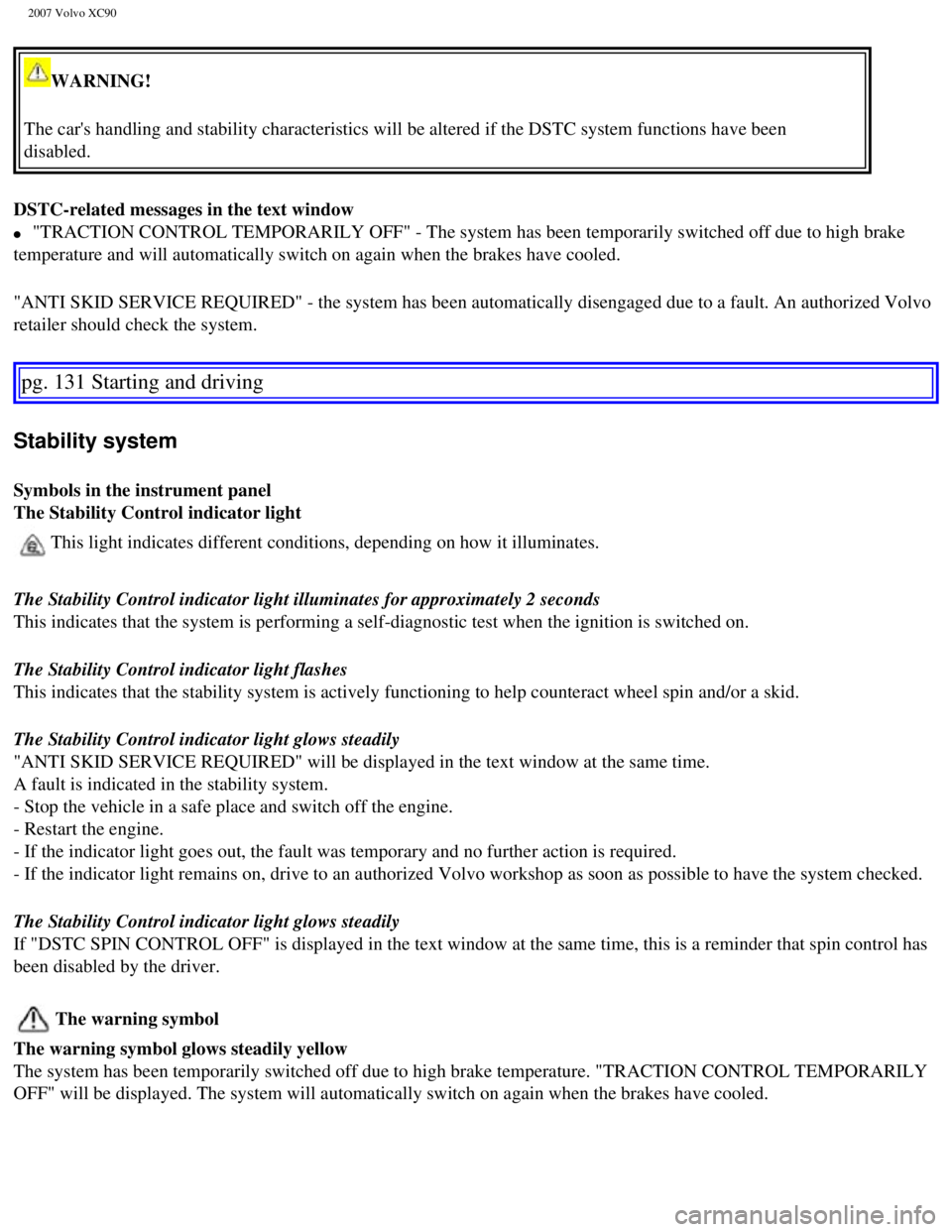
2007 Volvo XC90
WARNING!
The car's handling and stability characteristics will be altered if the \
DSTC system functions have been
disabled.
DSTC-related messages in the text window
l "TRACTION CONTROL TEMPORARILY OFF" - The system has been temporarily swi\
tched off due to high brake
temperature and will automatically switch on again when the brakes have \
cooled.
"ANTI SKID SERVICE REQUIRED" - the system has been automatically disenga\
ged due to a fault. An authorized Volvo
retailer should check the system.
pg. 131 Starting and driving
Stability system
Symbols in the instrument panel
The Stability Control indicator light
This light indicates different conditions, depending on how it illuminat\
es.
The Stability Control indicator light illuminates for approximately 2 se\
conds
This indicates that the system is performing a self-diagnostic test when\
the ignition is switched on.
The Stability Control indicator light flashes
This indicates that the stability system is actively functioning to help\
counteract wheel spin and/or a skid.
The Stability Control indicator light glows steadily
"ANTI SKID SERVICE REQUIRED" will be displayed in the text window at the\
same time.
A fault is indicated in the stability system.
- Stop the vehicle in a safe place and switch off the engine.
- Restart the engine.
- If the indicator light goes out, the fault was temporary and no furthe\
r action is required.
- If the indicator light remains on, drive to an authorized Volvo worksh\
op as soon as possible to have the system checked.
The Stability Control indicator light glows steadily
If "DSTC SPIN CONTROL OFF" is displayed in the text window at the same t\
ime, this is a reminder that spin control has
been disabled by the driver.
The warning symbol
The warning symbol glows steadily yellow
The system has been temporarily switched off due to high brake temperatu\
re. "TRACTION CONTROL TEMPORARILY
OFF" will be displayed. The system will automatically switch on again wh\
en the brakes have cooled.
file:///K|/ownersdocs/2007/2007_XC90/07xc90_06.htm (17 of 32)12/30/200\
6 5:53:44 PM
Page 142 of 268
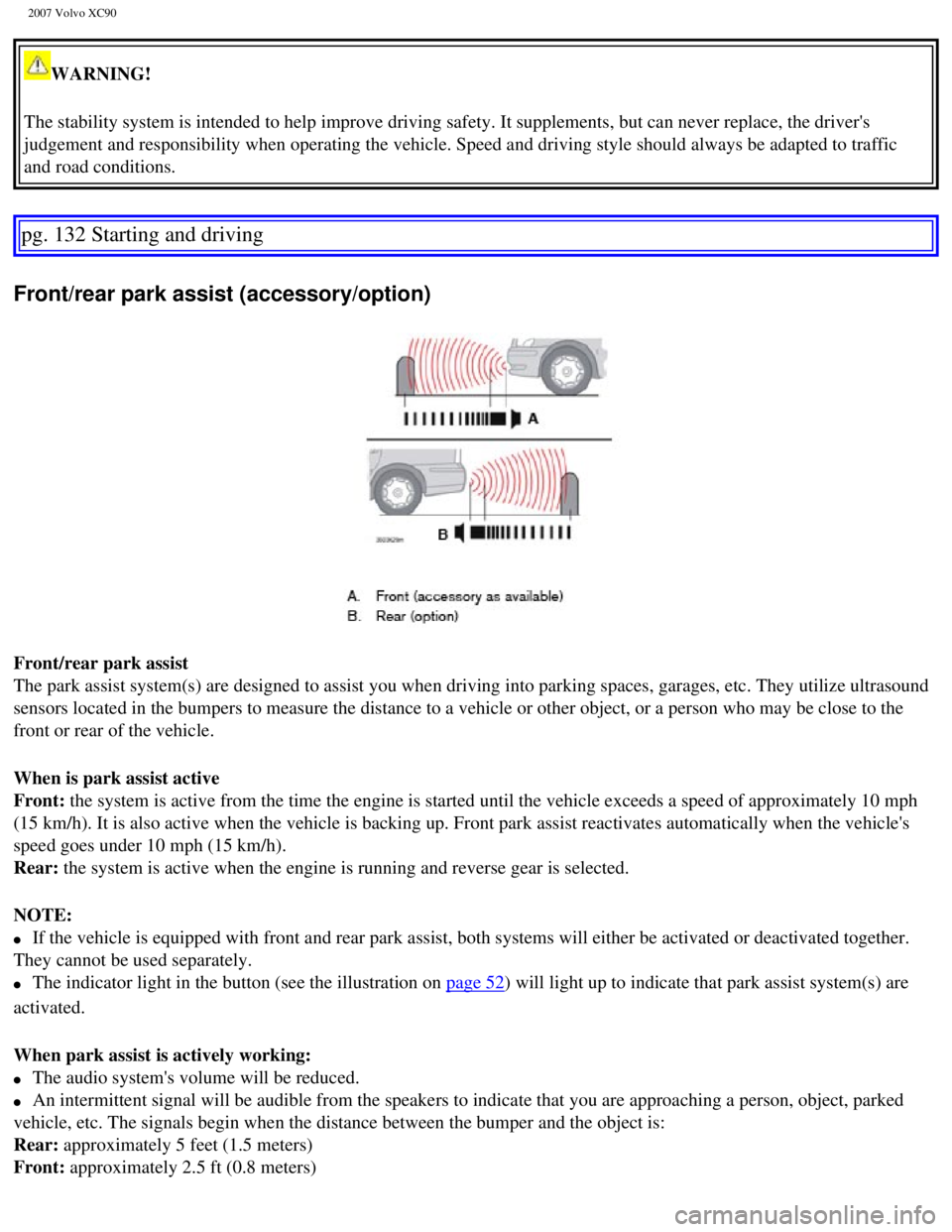
2007 Volvo XC90
WARNING!
The stability system is intended to help improve driving safety. It supp\
lements, but can never replace, the driver's
judgement and responsibility when operating the vehicle. Speed and drivi\
ng style should always be adapted to traffic
and road conditions.
pg. 132 Starting and driving
Front/rear park assist (accessory/option)
Front/rear park assist
The park assist system(s) are designed to assist you when driving into\
parking spaces, garages, etc. They utilize ultrasound
sensors located in the bumpers to measure the distance to a vehicle or o\
ther object, or a person who may be close to the
front or rear of the vehicle.
When is park assist active
Front: the system is active from the time the engine is started until the vehi\
cle exceeds a speed of approximately 10 mph
(15 km/h). It is also active when the vehicle is backing up. Front par\
k assist reactivates automatically when the vehicle's
speed goes under 10 mph (15 km/h).
Rear: the system is active when the engine is running and reverse gear is sel\
ected.
NOTE:
l If the vehicle is equipped with front and rear park assist, both systems\
will either be activated or deactivated together.
They cannot be used separately.
l The indicator light in the button (see the illustration on page 52) will light up to indicate that park assist system(s) are
activated.
When park assist is actively working:
l The audio system's volume will be reduced.
l An intermittent signal will be audible from the speakers to indicate tha\
t you are approaching a person, object, parked
vehicle, etc. The signals begin when the distance between the bumper and\
the object is:
Rear: approximately 5 feet (1.5 meters)
Front: approximately 2.5 ft (0.8 meters)
file:///K|/ownersdocs/2007/2007_XC90/07xc90_06.htm (18 of 32)12/30/200\
6 5:53:44 PM
Page 143 of 268
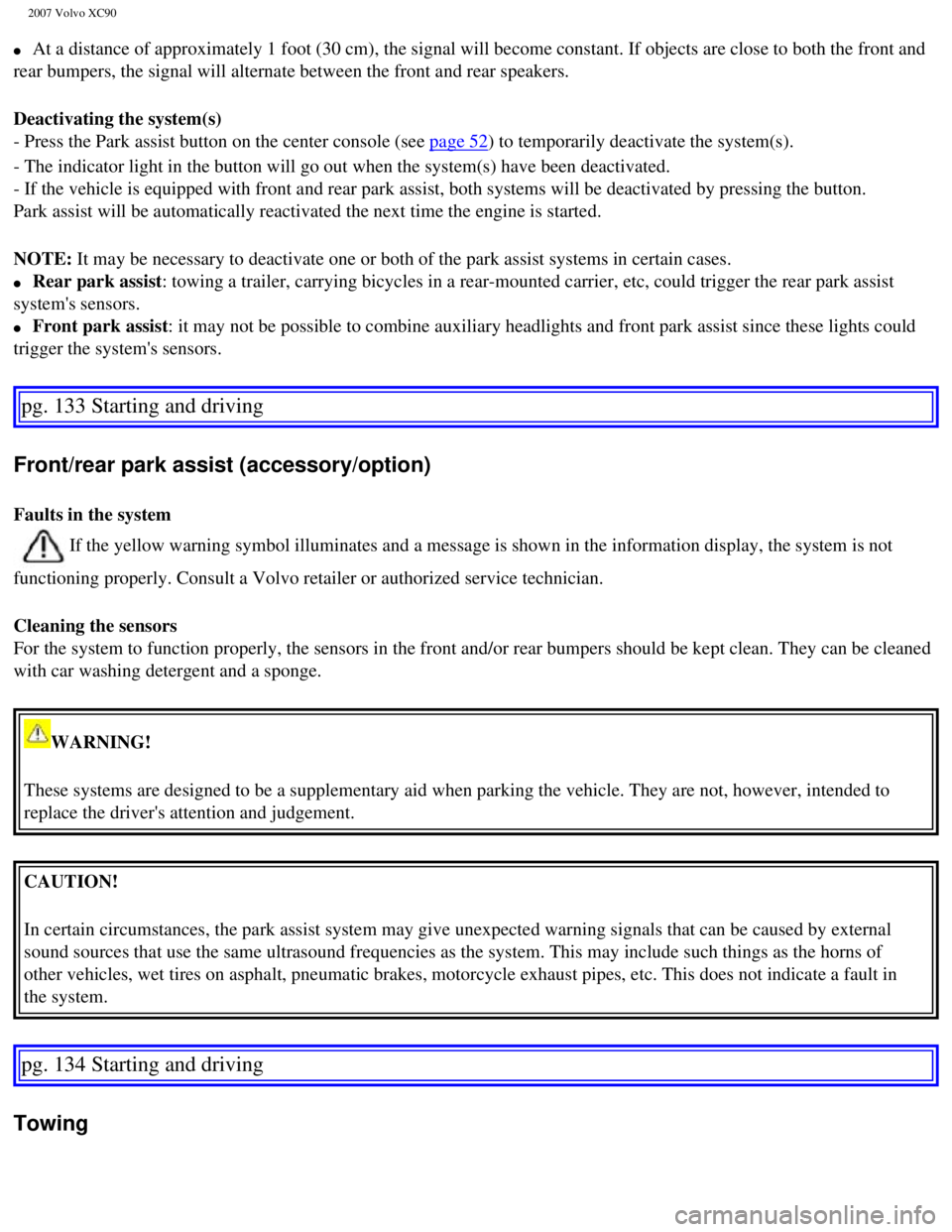
2007 Volvo XC90
l At a distance of approximately 1 foot (30 cm), the signal will become \
constant. If objects are close to both the front and
rear bumpers, the signal will alternate between the front and rear speak\
ers.
Deactivating the system(s)
- Press the Park assist button on the center console (see
page 52) to temporarily deactivate the system(s).
- The indicator light in the button will go out when the system(s) hav\
e been deactivated.
- If the vehicle is equipped with front and rear park assist, both syste\
ms will be deactivated by pressing the button.
Park assist will be automatically reactivated the next time the engine i\
s started.
NOTE: It may be necessary to deactivate one or both of the park assist system\
s in certain cases.
l Rear park assist: towing a trailer, carrying bicycles in a rear-mounted carrier, etc, co\
uld trigger the rear park assist
system's sensors.
l Front park assist: it may not be possible to combine auxiliary headlights and front park \
assist since these lights could
trigger the system's sensors.
pg. 133 Starting and driving
Front/rear park assist (accessory/option)
Faults in the system
If the yellow warning symbol illuminates and a message is shown in the i\
nformation display, the system is not
functioning properly. Consult a Volvo retailer or authorized service tec\
hnician.
Cleaning the sensors
For the system to function properly, the sensors in the front and/or rea\
r bumpers should be kept clean. They can be cleaned
with car washing detergent and a sponge.
WARNING!
These systems are designed to be a supplementary aid when parking the ve\
hicle. They are not, however, intended to
replace the driver's attention and judgement.
CAUTION!
In certain circumstances, the park assist system may give unexpected war\
ning signals that can be caused by external
sound sources that use the same ultrasound frequencies as the system. Th\
is may include such things as the horns of
other vehicles, wet tires on asphalt, pneumatic brakes, motorcycle exhau\
st pipes, etc. This does not indicate a fault in
the system.
pg. 134 Starting and driving
Towing
file:///K|/ownersdocs/2007/2007_XC90/07xc90_06.htm (19 of 32)12/30/200\
6 5:53:44 PM
Page 144 of 268
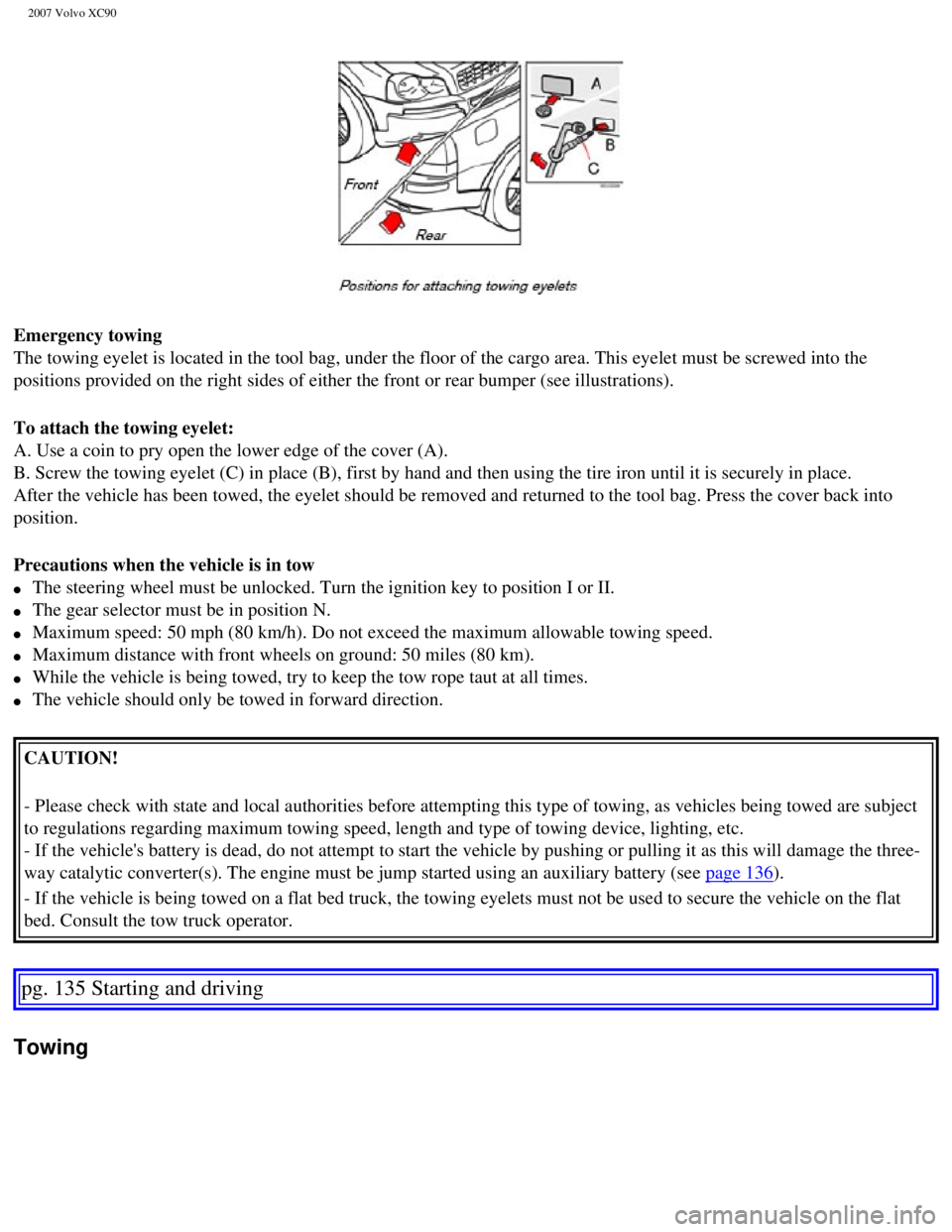
2007 Volvo XC90
Emergency towing
The towing eyelet is located in the tool bag, under the floor of the car\
go area. This eyelet must be screwed into the
positions provided on the right sides of either the front or rear bumper\
(see illustrations).
To attach the towing eyelet:
A. Use a coin to pry open the lower edge of the cover (A).
B. Screw the towing eyelet (C) in place (B), first by hand and then \
using the tire iron until it is securely in place.
After the vehicle has been towed, the eyelet should be removed and retur\
ned to the tool bag. Press the cover back into
position.
Precautions when the vehicle is in tow
l The steering wheel must be unlocked. Turn the ignition key to position I\
or II.
l The gear selector must be in position N.
l Maximum speed: 50 mph (80 km/h). Do not exceed the maximum allowable t\
owing speed.
l Maximum distance with front wheels on ground: 50 miles (80 km).
l While the vehicle is being towed, try to keep the tow rope taut at all t\
imes.
l The vehicle should only be towed in forward direction.
CAUTION!
- Please check with state and local authorities before attempting this t\
ype of towing, as vehicles being towed are subject
to regulations regarding maximum towing speed, length and type of towing\
device, lighting, etc.
- If the vehicle's battery is dead, do not attempt to start the vehicle \
by pushing or pulling it as this will damage the three-
way catalytic converter(s). The engine must be jump started using an a\
uxiliary battery (see
page 136).
- If the vehicle is being towed on a flat bed truck, the towing eyelets \
must not be used to secure the vehicle on the flat
bed. Consult the tow truck operator.
pg. 135 Starting and driving
Towing
file:///K|/ownersdocs/2007/2007_XC90/07xc90_06.htm (20 of 32)12/30/200\
6 5:53:44 PM
Page 145 of 268
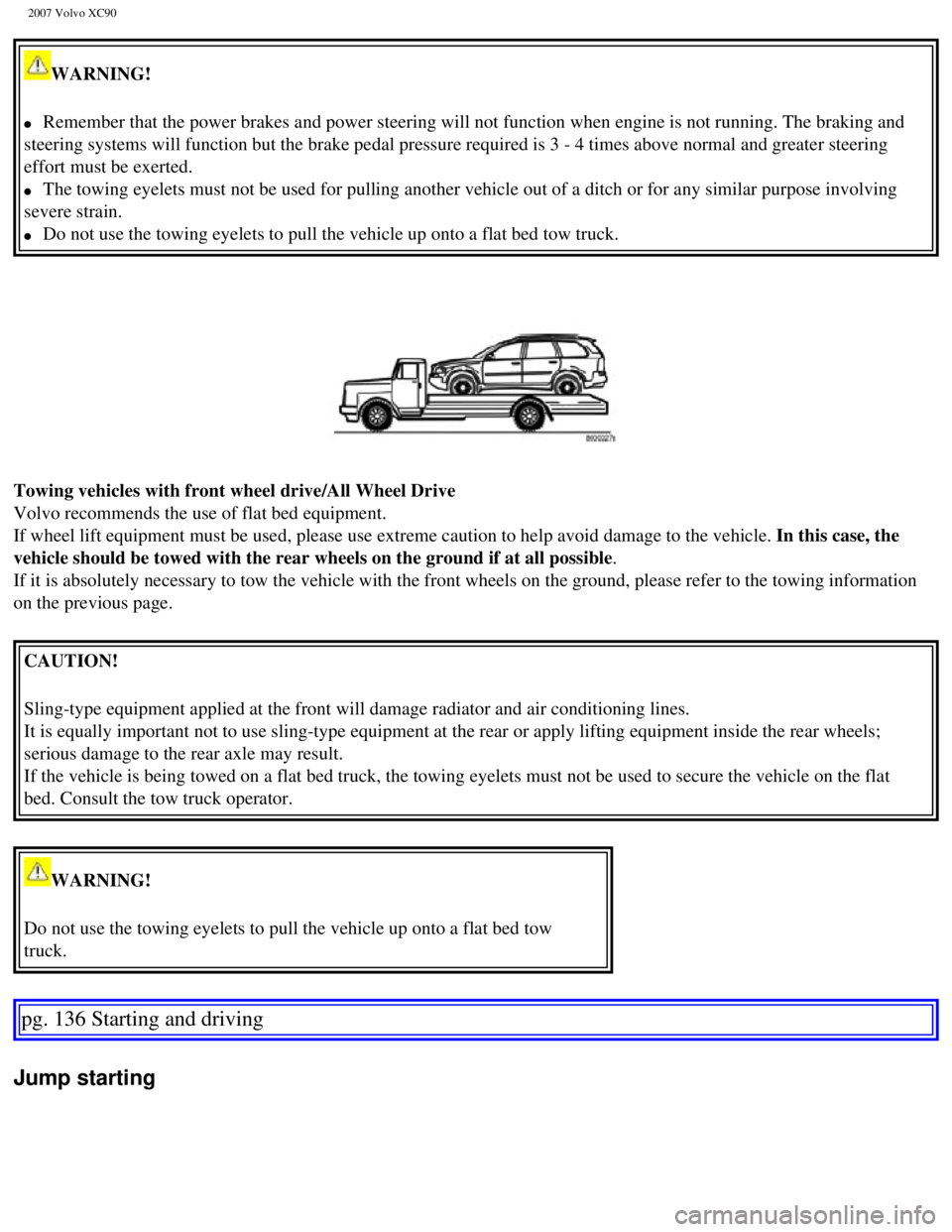
2007 Volvo XC90
WARNING!
l Remember that the power brakes and power steering will not function when\
engine is not running. The braking and
steering systems will function but the brake pedal pressure required is \
3 - 4 times above normal and greater steering
effort must be exerted.
l The towing eyelets must not be used for pulling another vehicle out of a\
ditch or for any similar purpose involving
severe strain.
l Do not use the towing eyelets to pull the vehicle up onto a flat bed tow\
truck.
Towing vehicles with front wheel drive/All Wheel Drive
Volvo recommends the use of flat bed equipment.
If wheel lift equipment must be used, please use extreme caution to help\
avoid damage to the vehicle. In this case, the
vehicle should be towed with the rear wheels on the ground if at all pos\
sible.
If it is absolutely necessary to tow the vehicle with the front wheels o\
n the ground, please refer to the towing information
on the previous page.
CAUTION!
Sling-type equipment applied at the front will damage radiator and air c\
onditioning lines.
It is equally important not to use sling-type equipment at the rear or a\
pply lifting equipment inside the rear wheels;
serious damage to the rear axle may result.
If the vehicle is being towed on a flat bed truck, the towing eyelets mu\
st not be used to secure the vehicle on the flat
bed. Consult the tow truck operator.
WARNING!
Do not use the towing eyelets to pull the vehicle up onto a flat bed tow\
truck.
pg. 136 Starting and driving
Jump starting
file:///K|/ownersdocs/2007/2007_XC90/07xc90_06.htm (21 of 32)12/30/200\
6 5:53:44 PM
Page 146 of 268
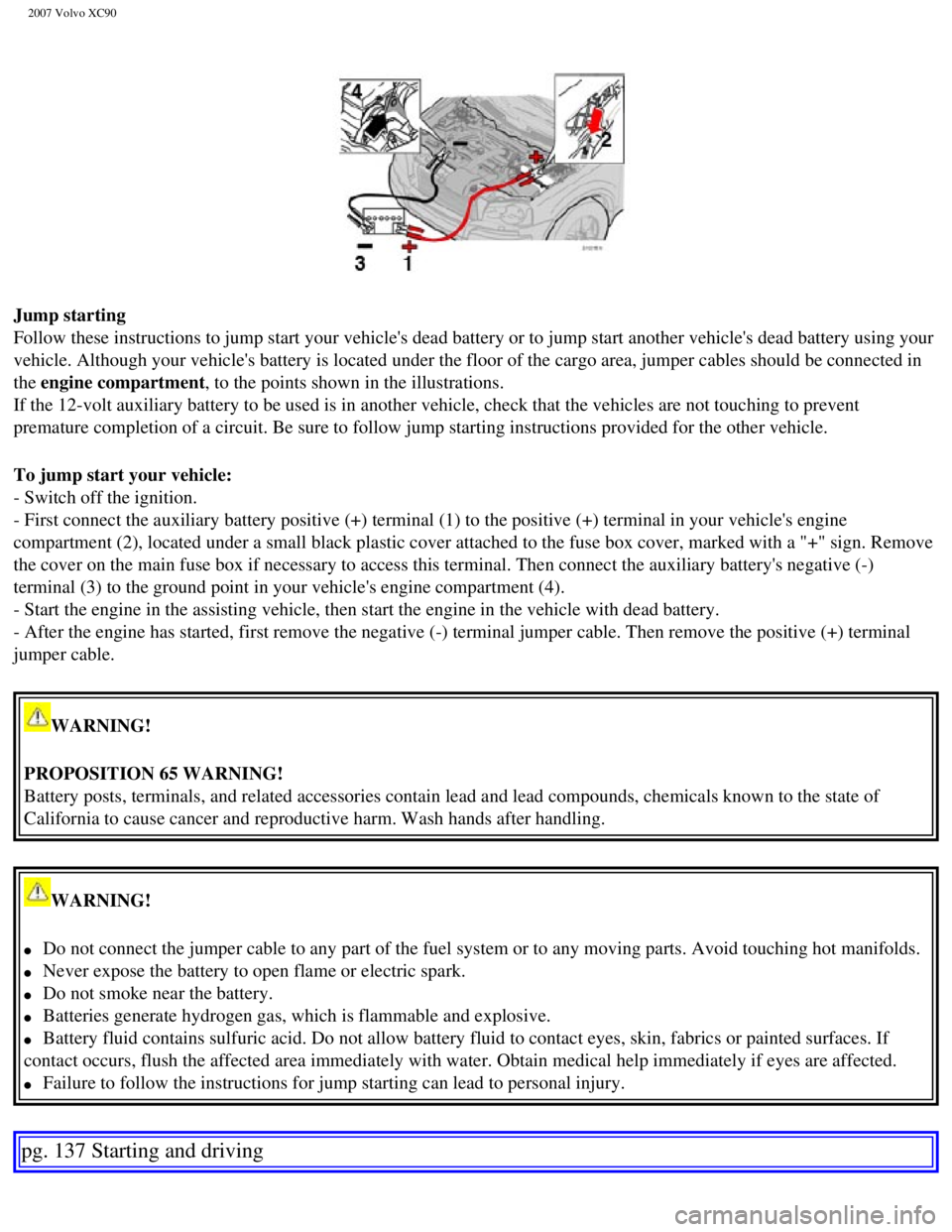
2007 Volvo XC90
Jump starting
Follow these instructions to jump start your vehicle's dead battery or t\
o jump start another vehicle's dead battery using your
vehicle. Although your vehicle's battery is located under the floor of t\
he cargo area, jumper cables should be connected in
the engine compartment, to the points shown in the illustrations.
If the 12-volt auxiliary battery to be used is in another vehicle, check\
that the vehicles are not touching to prevent
premature completion of a circuit. Be sure to follow jump starting instr\
uctions provided for the other vehicle.
To jump start your vehicle:
- Switch off the ignition.
- First connect the auxiliary battery positive (+) terminal (1) to t\
he positive (+) terminal in your vehicle's engine
compartment (2), located under a small black plastic cover attached to\
the fuse box cover, marked with a "+" sign. Remove
the cover on the main fuse box if necessary to access this terminal. The\
n connect the auxiliary battery's negative (-)
terminal (3) to the ground point in your vehicle's engine compartment \
(4).
- Start the engine in the assisting vehicle, then start the engine in th\
e vehicle with dead battery.
- After the engine has started, first remove the negative (-) terminal\
jumper cable. Then remove the positive (+) terminal
jumper cable.
WARNING!
PROPOSITION 65 WARNING!
Battery posts, terminals, and related accessories contain lead and lead \
compounds, chemicals known to the state of
California to cause cancer and reproductive harm. Wash hands after handl\
ing.
WARNING!
l Do not connect the jumper cable to any part of the fuel system or to any\
moving parts. Avoid touching hot manifolds.
l Never expose the battery to open flame or electric spark.
l Do not smoke near the battery.
l Batteries generate hydrogen gas, which is flammable and explosive.
l Battery fluid contains sulfuric acid. Do not allow battery fluid to cont\
act eyes, skin, fabrics or painted surfaces. If
contact occurs, flush the affected area immediately with water. Obtain m\
edical help immediately if eyes are affected.
l Failure to follow the instructions for jump starting can lead to persona\
l injury.
pg. 137 Starting and driving
file:///K|/ownersdocs/2007/2007_XC90/07xc90_06.htm (22 of 32)12/30/200\
6 5:53:44 PM
Page 147 of 268
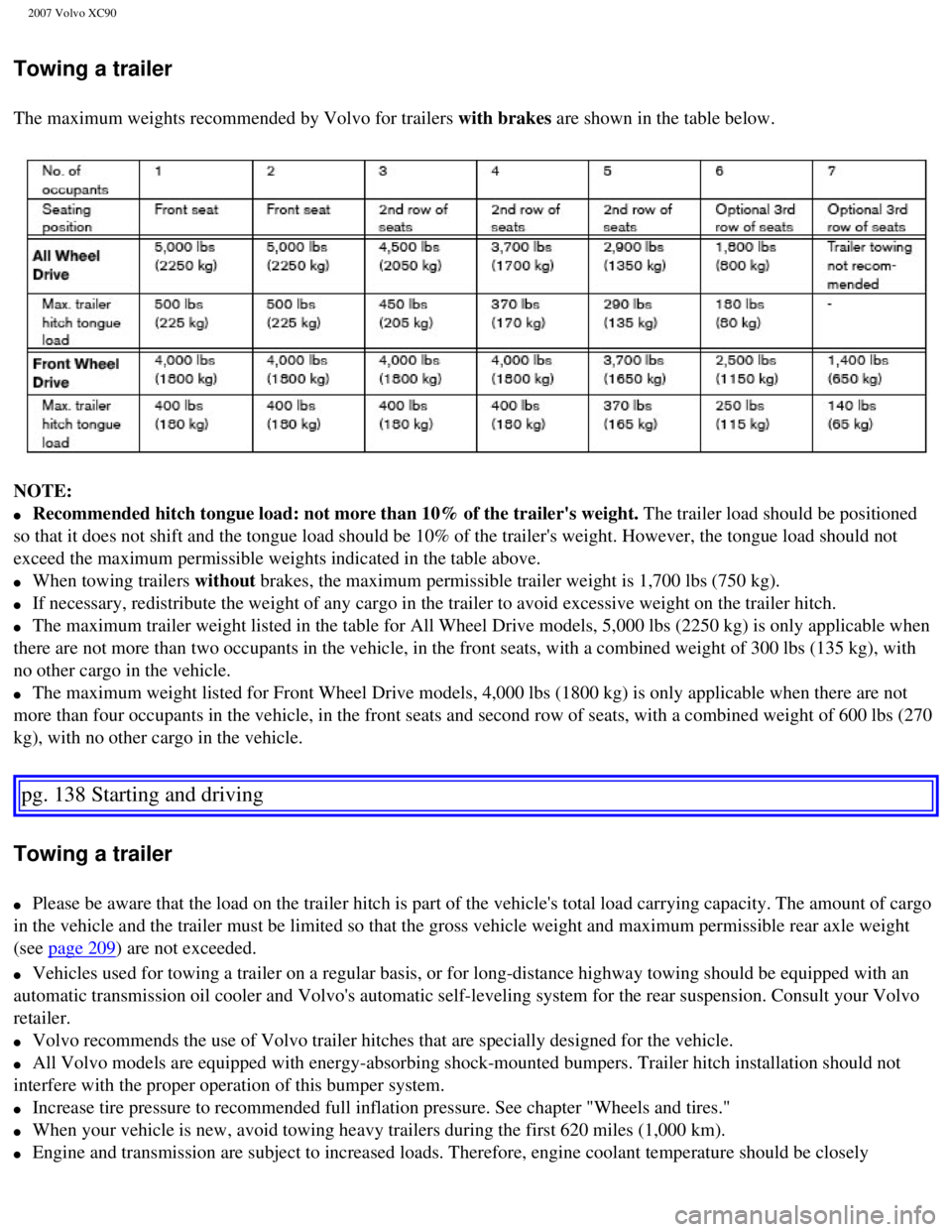
2007 Volvo XC90
Towing a trailer
The maximum weights recommended by Volvo for trailers with brakes are shown in the table below.
NOTE:
l Recommended hitch tongue load: not more than 10% of the trailer's weight\
. The trailer load should be positioned
so that it does not shift and the tongue load should be 10% of the trail\
er's weight. However, the tongue load should not
exceed the maximum permissible weights indicated in the table above.
l When towing trailers without brakes, the maximum permissible trailer weight is 1,700 lbs (750 kg).\
l If necessary, redistribute the weight of any cargo in the trailer to avo\
id excessive weight on the trailer hitch.
l The maximum trailer weight listed in the table for All Wheel Drive model\
s, 5,000 lbs (2250 kg) is only applicable when
there are not more than two occupants in the vehicle, in the front seats\
, with a combined weight of 300 lbs (135 kg), with
no other cargo in the vehicle.
l The maximum weight listed for Front Wheel Drive models, 4,000 lbs (1800\
kg) is only applicable when there are not
more than four occupants in the vehicle, in the front seats and second r\
ow of seats, with a combined weight of 600 lbs (270
kg), with no other cargo in the vehicle.
pg. 138 Starting and driving
Towing a trailer
l Please be aware that the load on the trailer hitch is part of the vehicl\
e's total load carrying capacity. The amount of cargo
in the vehicle and the trailer must be limited so that the gross vehicle\
weight and maximum permissible rear axle weight
(see
page 209) are not exceeded.
l Vehicles used for towing a trailer on a regular basis, or for long-dista\
nce highway towing should be equipped with an
automatic transmission oil cooler and Volvo's automatic self-leveling sy\
stem for the rear suspension. Consult your Volvo
retailer.
l Volvo recommends the use of Volvo trailer hitches that are specially des\
igned for the vehicle.
l All Volvo models are equipped with energy-absorbing shock-mounted bumper\
s. Trailer hitch installation should not
interfere with the proper operation of this bumper system.
l Increase tire pressure to recommended full inflation pressure. See chapt\
er "Wheels and tires."
l When your vehicle is new, avoid towing heavy trailers during the first 6\
20 miles (1,000 km).
l Engine and transmission are subject to increased loads. Therefore, engin\
e coolant temperature should be closely
file:///K|/ownersdocs/2007/2007_XC90/07xc90_06.htm (23 of 32)12/30/200\
6 5:53:44 PM
Page 148 of 268
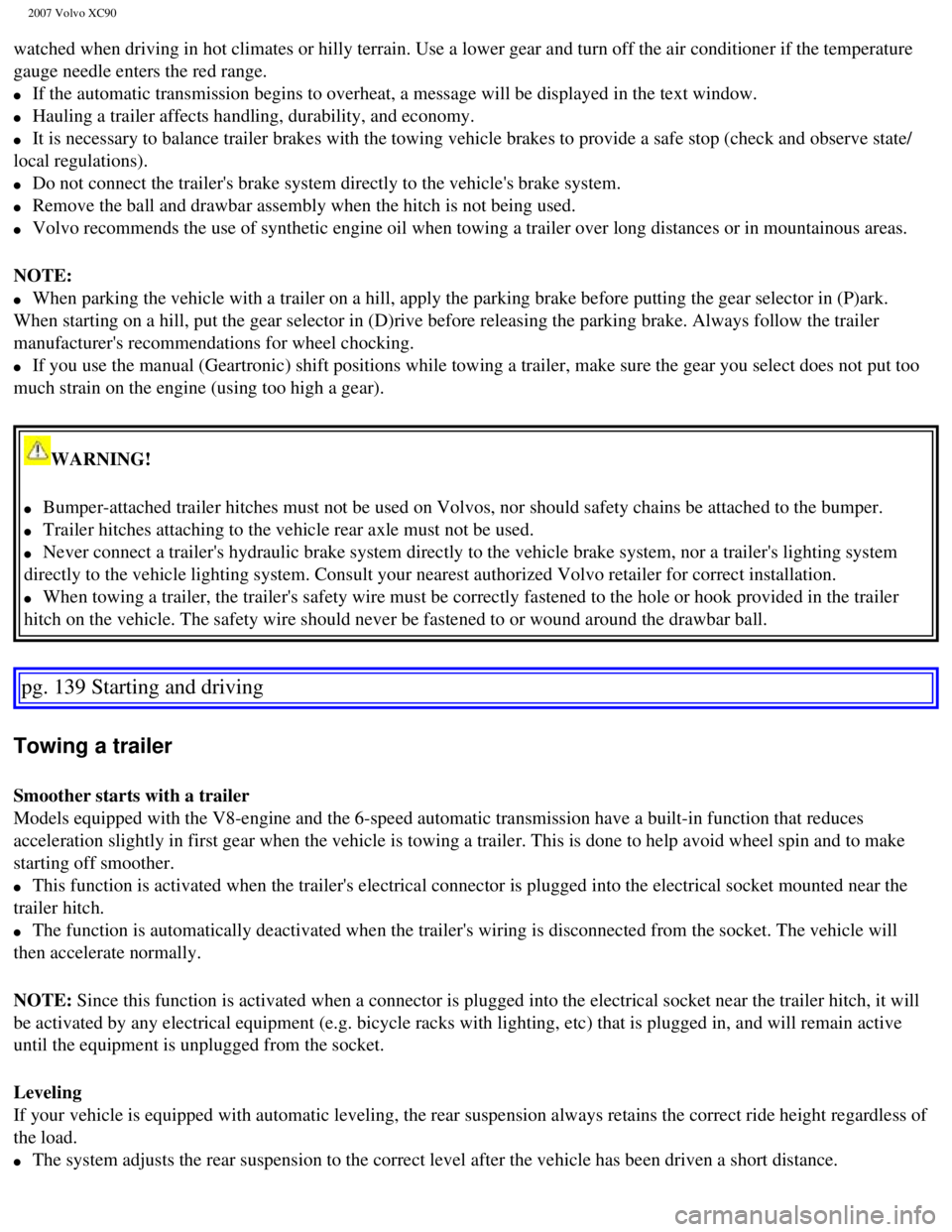
2007 Volvo XC90
watched when driving in hot climates or hilly terrain. Use a lower gear \
and turn off the air conditioner if the temperature
gauge needle enters the red range.
l If the automatic transmission begins to overheat, a message will be disp\
layed in the text window.
l Hauling a trailer affects handling, durability, and economy.
l It is necessary to balance trailer brakes with the towing vehicle brakes\
to provide a safe stop (check and observe state/
local regulations).
l Do not connect the trailer's brake system directly to the vehicle's brak\
e system.
l Remove the ball and drawbar assembly when the hitch is not being used.
l Volvo recommends the use of synthetic engine oil when towing a trailer o\
ver long distances or in mountainous areas.
NOTE:
l When parking the vehicle with a trailer on a hill, apply the parking bra\
ke before putting the gear selector in (P)ark.
When starting on a hill, put the gear selector in (D)rive before relea\
sing the parking brake. Always follow the trailer
manufacturer's recommendations for wheel chocking.
l If you use the manual (Geartronic) shift positions while towing a trai\
ler, make sure the gear you select does not put too
much strain on the engine (using too high a gear).
WARNING!
l Bumper-attached trailer hitches must not be used on Volvos, nor should s\
afety chains be attached to the bumper.
l Trailer hitches attaching to the vehicle rear axle must not be used.
l Never connect a trailer's hydraulic brake system directly to the vehicle\
brake system, nor a trailer's lighting system
directly to the vehicle lighting system. Consult your nearest authorized\
Volvo retailer for correct installation.
l When towing a trailer, the trailer's safety wire must be correctly faste\
ned to the hole or hook provided in the trailer
hitch on the vehicle. The safety wire should never be fastened to or wou\
nd around the drawbar ball.
pg. 139 Starting and driving
Towing a trailer
Smoother starts with a trailer
Models equipped with the V8-engine and the 6-speed automatic transmissio\
n have a built-in function that reduces
acceleration slightly in first gear when the vehicle is towing a trailer\
. This is done to help avoid wheel spin and to make
starting off smoother.
l This function is activated when the trailer's electrical connector is pl\
ugged into the electrical socket mounted near the
trailer hitch.
l The function is automatically deactivated when the trailer's wiring is d\
isconnected from the socket. The vehicle will
then accelerate normally.
NOTE: Since this function is activated when a connector is plugged into the e\
lectrical socket near the trailer hitch, it will
be activated by any electrical equipment (e.g. bicycle racks with light\
ing, etc) that is plugged in, and will remain active
until the equipment is unplugged from the socket.
Leveling
If your vehicle is equipped with automatic leveling, the rear suspension\
always retains the correct ride height regardless of
the load.
l The system adjusts the rear suspension to the correct level after the ve\
hicle has been driven a short distance.
file:///K|/ownersdocs/2007/2007_XC90/07xc90_06.htm (24 of 32)12/30/200\
6 5:53:44 PM
Page 149 of 268
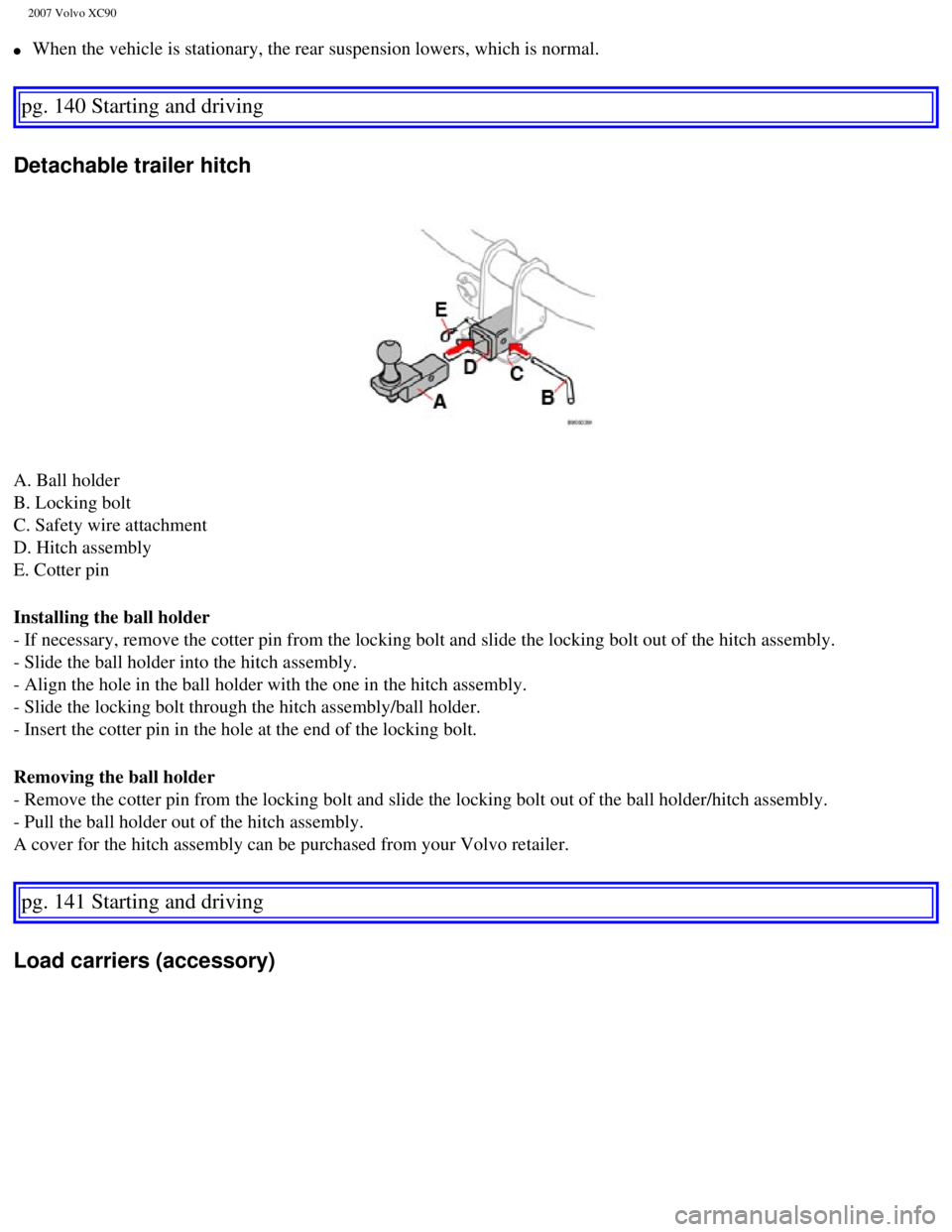
2007 Volvo XC90
l When the vehicle is stationary, the rear suspension lowers, which is nor\
mal.
pg. 140 Starting and driving
Detachable trailer hitch
A. Ball holder
B. Locking bolt
C. Safety wire attachment
D. Hitch assembly
E. Cotter pin
Installing the ball holder
- If necessary, remove the cotter pin from the locking bolt and slide th\
e locking bolt out of the hitch assembly.
- Slide the ball holder into the hitch assembly.
- Align the hole in the ball holder with the one in the hitch assembly. \
- Slide the locking bolt through the hitch assembly/ball holder.
- Insert the cotter pin in the hole at the end of the locking bolt.
Removing the ball holder
- Remove the cotter pin from the locking bolt and slide the locking bolt\
out of the ball holder/hitch assembly.
- Pull the ball holder out of the hitch assembly.
A cover for the hitch assembly can be purchased from your Volvo retailer\
.
pg. 141 Starting and driving
Load carriers (accessory)
file:///K|/ownersdocs/2007/2007_XC90/07xc90_06.htm (25 of 32)12/30/200\
6 5:53:44 PM
Page 150 of 268
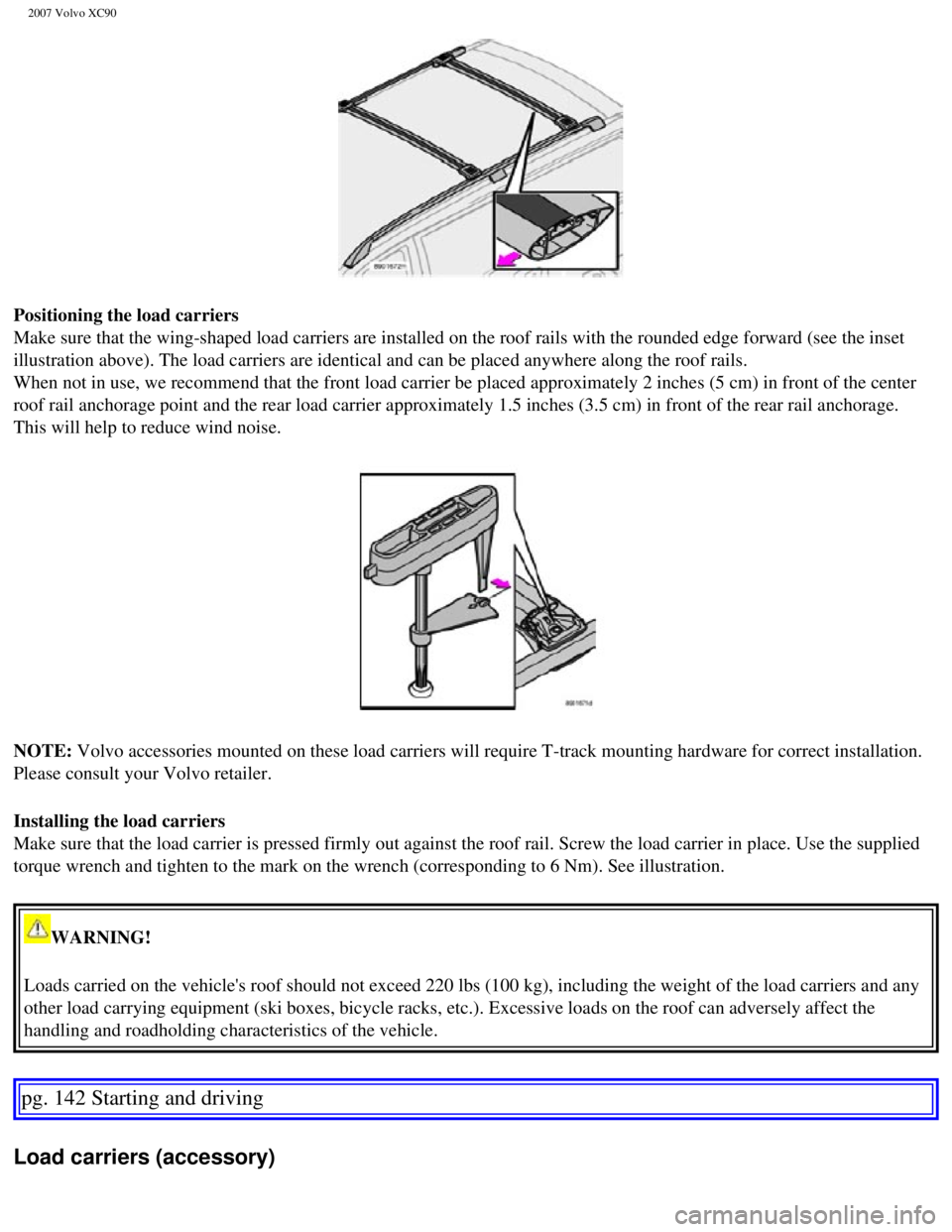
2007 Volvo XC90
Positioning the load carriers
Make sure that the wing-shaped load carriers are installed on the roof r\
ails with the rounded edge forward (see the inset
illustration above). The load carriers are identical and can be placed \
anywhere along the roof rails.
When not in use, we recommend that the front load carrier be placed appr\
oximately 2 inches (5 cm) in front of the center
roof rail anchorage point and the rear load carrier approximately 1.5 in\
ches (3.5 cm) in front of the rear rail anchorage.
This will help to reduce wind noise.
NOTE: Volvo accessories mounted on these load carriers will require T-track m\
ounting hardware for correct installation.
Please consult your Volvo retailer.
Installing the load carriers
Make sure that the load carrier is pressed firmly out against the roof r\
ail. Screw the load carrier in place. Use the supplied
torque wrench and tighten to the mark on the wrench (corresponding to 6\
Nm). See illustration.
WARNING!
Loads carried on the vehicle's roof should not exceed 220 lbs (100 kg)\
, including the weight of the load carriers and any
other load carrying equipment (ski boxes, bicycle racks, etc.). Excess\
ive loads on the roof can adversely affect the
handling and roadholding characteristics of the vehicle.
pg. 142 Starting and driving
Load carriers (accessory)
file:///K|/ownersdocs/2007/2007_XC90/07xc90_06.htm (26 of 32)12/30/200\
6 5:53:44 PM